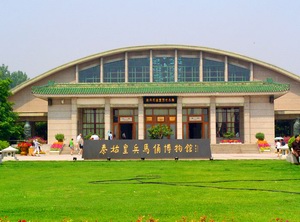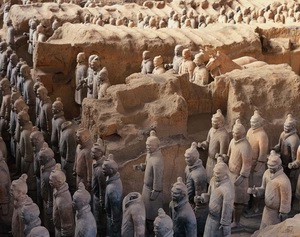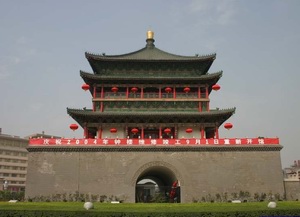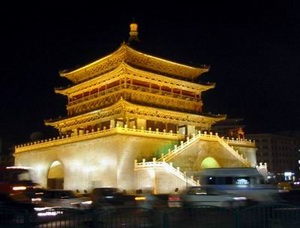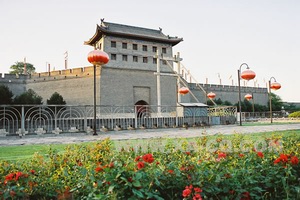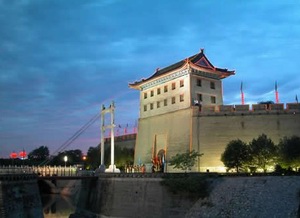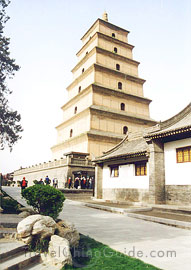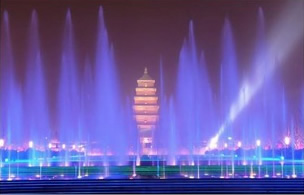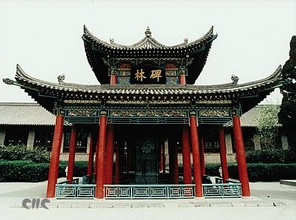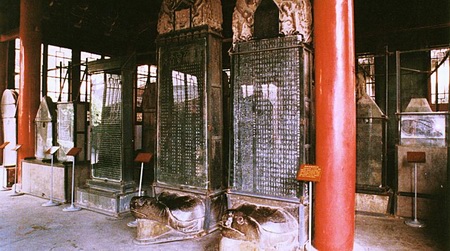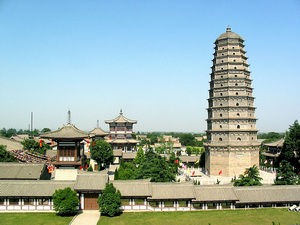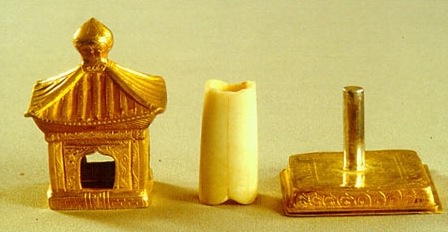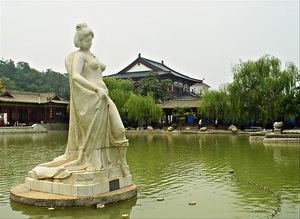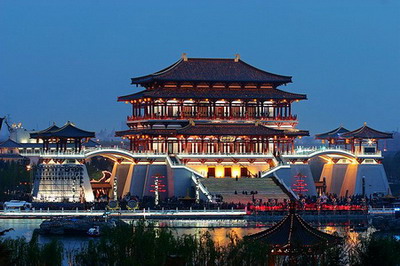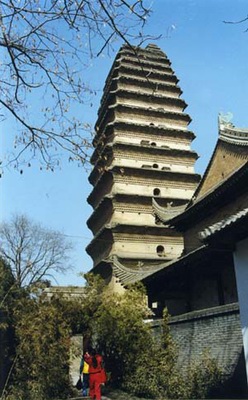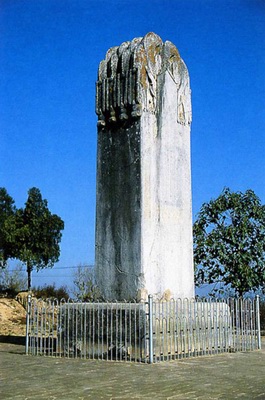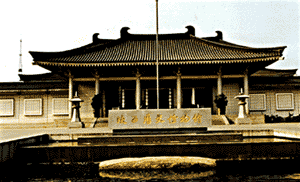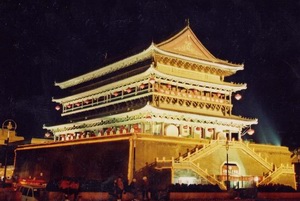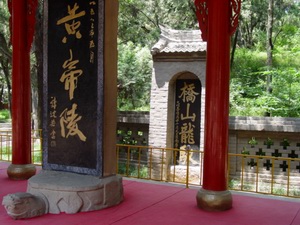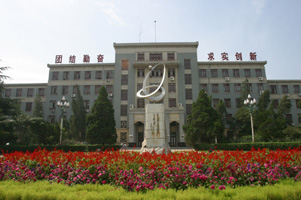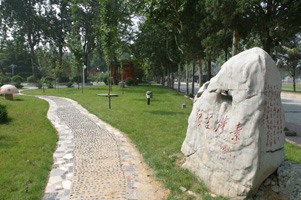| |
Welcome
to Xi'an
A world-famous tourist city and a treasure house of
cultural relics.
Xian,
the eternal city, records the great changes of the
Chinese nation just like a living history book. Called
Chang'an in ancient times, Xian is one of the birthplaces
of the ancient civilization in the Yellow River Basin
area of the country. During Xian's 3,100 year development,
13 dynasties such as Zhou, Qin, Han and Tang placed
their capitals here. So far, Xian enjoys equal fame
with Athens, Cairo, and Rome as one of the four major
ancient civilization capitals.
Xian
is the capital of Shaanxi province, located
in the southern part of the GuanZhong Plain.
With the Qinling Mountains to the north and
the Weihe River to the south, it is in a favorable
geographical location surrounded by water
and hills. It has a semi-moist monsoon climate
and there is a clear distinction between the
four seasons. Except the colder winter, any
season is relatively suitable for traveling.
The
cultural and historical significance of the
area, as well as the abundant relics and sites,
help Xian enjoy the laudatory title of "Natural
History Museum". The Museum of Terra
Cotta Warriors and Horses is praised as
"the eighth major miracle of the world",
Mausoleum
of Emperor Qin Shi Huang is listed on
the World Heritage List, and the City Wall
of the Ming Dynasty is the largest and most
intact Ming Dynasty castle in the world. In
the city, there is the 3000 year old Banpo
Village Remains from the Neolithic Age, and
the Forest
of Stone Steles that holds 3,000 stone
steles of different periods from the Han Dynasty
to the Qing Dynasty. Around Xi'an, the Famen
Temple enjoys the reputation of being
the "forefather of pagodas and temples
in Central Shaanxi," because it holds
the finger bones of Sakyamuni--the founder
of Buddhism. The natural landscape around
Xian is also marvelous. Mt.
Huashan, as one of the five best-known
mountains in China, is famous for its breath-taking
cliffs and its unique characteristics.
As
tourist development grows in Xian, the hotel
industry flourishes more and more. It is very
easy to find a hotel in Xian, ranging from
5 star hotels to youth hostels. Of course,
it will be any traveler's first choice to
stay in the city center due to the superior
geographical location and the convenient transportation.
Praised
as "the capital of table delicacies",
Xian has been rich in the delicious Shaanxi
snack, delicate Guangdong Cuisine, various
kinds of fashionable foreign delicacies, and
popular Sichuan Cuisine such as the hot pot.
Among all the delicacies, the most famous
and popular one is the Muslim Snack Street.
Xian
is the most important city in northwest China,
and so there are a lot of shopping outlets
for locals and tourists alike. There are many
big shopping centers, department stores and
supermarkets in and around Xian city - the
biggest and most comprehensive being Kai Yuan
Shopping Mall and Century Ginwa Shopping Mall.
The
night life in Xian has a unique glamour. Traditional
ways include enjoying the night scenery around
the Bell Tower, taking part in a Tang Dynasty
Dinner Show, strolling on the ancient Big
Wild Goose Pagoda Square and watching the
music fountain performance. More modern and
fashionable ways include singing in the KTV,
hanging out in a bar, or dancing in a Disco.
All in all, any experience in this ancient
city will bring you fun and possibly a little
surprise!
|
Sightseening
in Xi'an
Terra
Cotta Warriors and Horses
The
well-known Terra-cotta Museum is located east
of Emperor Qin's Mausoleum, which covers a
total area of 20 hectares. The museum is decorated
with verdant trees,blooming flowers and carpets
of green grass. The scenery in the museum
looks quite elegant and delightful. Three
main buildings of the museum, which were named
Pit 1,Pit 2, Pit 3, were constructed on their
original sites in different periods of time.
Emperor
Qin's Terra-cotta Museum is not only a treasure
house where the tourists can learn history,
culture and human civilization, but also a
main scenic spot of Xi'an city. It can receive
about 1.5 million tourists annually. Approximately
40 million visitors from home and abroad have
visited the Museum within the last 20 years.
Today "the eighth Wonder of the world"
has almost become synonym of the Terra-cotta
Warriors and Horses In 1987, the Emperor Qin's
Mausoleum was put on the list of the UNESCO
as a world-class cultural heritage site. Now
the Museum is well-known widely as a huge
modern on-site museum and it is going to be
one of the best in the world.
|
Bell
Tower (Zhong Lou)
The
Bell Tower, is a stately traditional building,
that marks the geographical center of the
ancient capital. From this important landmark
extend East, South, West and North Streets,
connecting the Tower to the East, South, West
and North Gates of the City
Wall of the Ming Dynasty.
The
wooden tower, which is the largest and best-preserved
of its kind in China, is 36 meters (118 feet)
high. It stands on a brick base 35.5 meters
(116.4 feet) long and 8.6 meters (28.2 feet)
high on each side. During the Ming Dynasty,
Xian was an important military town in Northwest
China, a fact that is reflected in the size
and historic significance of its tower.
|
City
Wall
When
Zhu Yuanzhang, the first Emperor of the Ming
dynasty (1368-1644), captured Huizhou, a hermit
named Zhu Sheng admonished him that he should
"built high walls, store abundant food
supplies and take time to be an Emperor,"
so that he could fortify the city and unify
the other states. After the establishment
of the Ming dynasty, Zhu Yuanzhang followed
his advice and began to enlarge the wall built
initially during the old Tang dynasty (618
-907), creating the modern Xian City Wall.
It's the most complete city wall that has
survived in China, as well being one of the
largest ancient military defensive systems
in the world.
After
the extension, the wall now stands 12 meters
(40 feet) tall, 12-14 meters (40-46 feet)
wide at the top and 15-18 meters (50-60 feet)
thick at the bottom. It covers 13.7 kilometers
(8.5 miles) in length with a deep moat surrounding
it.
Every
120 meters, there is a rampart which extends
out from the main wall. All together, there
are 98 ramparts on the wall, which were built
to defend against the enemy climbing up the
wall. Each rampart has a sentry building,
in which the soldiers could protect the entire
wall without exposing themselves to the enemy.
Besides, the distance between every two ramparts
is just within the range of an arrow shot
from either side, so that they could shoot
the enemy, who wanted to attack the city,
from the side. On the outer side of the city
wall, there are 5948 crenellations, namely
battlements. The soldiers can outlook and
shoot at the enemy. On the inner side, parapets
were built to protect the soldiers from falling
off.
|
Big
Wild Goose Pagoda
| As
the symbol of the old-line Xian, Big Wild Goose
Pagoda is a well-preserved ancient building
and a holy place for Buddhists. It is located
in the southern suburb of Xian City, about 4
kilometers (2.49 miles) from the downtown of
the city. Standing in the Da Ci'en Temple complex,
it attracts numerous visitors for its fame in
the Buddhist religion, its simple but appealing
style of construction, and its new square in
front of the temple. It is rated as a National
Key Cultural Relic Preserve as well as an AAAA
Tourist Attraction.This attraction can be divided
into three parts: the Big Wild Goose Pagoda,
the Da Ci'en Temple, and the North Square of
Big Wild Goose Pagoda. |
Forest
of Stone Steles
Once
the site of the Temple of Confucius during the
Northern Song dynasty (960--1127), the Forest
of Stone Steles Museum is situated on Sanxue
Street, near the south gate of Xian City Wall.
It was initially established in AD 1087 when
some precious stone steles were moved here for
safe keeping, including the "Classic on
Filial Piety" written by Emperor Xuanzong
in AD 745 and "the Kaicheng Stone Steles"
arved in AD 837. With an area of 31,000 square
meters, the Forest of Stone Steles used to be
the principal museum for Shaanxi Province since
1944. Then because of the large number of stone
steles, it was officially named as the Forest
of Stone Steles Museum in 1992. |
Famen
Temple
In
China, many temples house treasures and artifacts,
but the sheer quantity and quality of treasures
in the Famen Temple is rare. Situated in Famen
Town of Fufeng County, about 120 kilometers
(about 74.57 miles) west of Xian, Famen Temple
is renowned for storing the veritable four slivers
of the finger bone of the Sakyamuni Buddha.
Famen Temple was established in the Eastern
Han Dynasty (25--220), for carrying forward
Buddhism. The most representative structures
in the temple are the Famen Temple Pagoda and
Famen Temple Museum. |
Mt.
Huashan
| |
|
| As
one of the five best-known mountains in China,
Mt. Huashan is located to the south of Huayin
city, 120 kilometers east of Xian, in Shaanxi
province, with an elevation of 2200 meters above
sea level. In ancient times, Mt. Huashan was
called Mt. Taihuashan. Seen from afar, the five
peaks looks like five petals of a flower. Hence
its name, Mt. Huashan (= five flowers). Today,
it is listed as one of the renowned national
scenic spots |
Huaqing
Hot Springs
| |
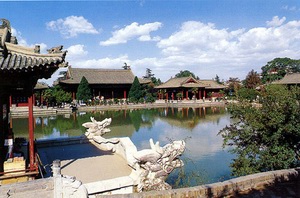 |
| Situated
at the northern foot of Mt. Lishan in Lintong
County, 30 kilometers (18.6 miles) from Xian
City, Huaqing Hot Spring is famed for both its
dainty spring scenery and the romantic love
story of Emperor Xuanzong (685-762) and his
concubine Yang Guifei in the Tang Dynasty (618-907).
Its long history and location among the wonderful
landscapes of Xian should entice any visitor
to visit and bathe in this hot spring.It is
said that King You built a palace here during
the Western Zhou Dynasty (11th century BC-711
BC). Additions were subsequently made by the
First Emperor Qing (259 BC-210BC) and Emperor
Wu during the Western Han Dynasty (206 BC-24).
During
his reign, the Emperor Xuanzong spent dizzying
amounts of his funds to build a luxurious palace,
changing its name to Huaqing Hot Spring or Huaqing
Palace. Over the course of 41 years in his days,
he visited the palace as many as 36 times. The
palace thus has a history of 3,000 years and
the hotspring a history of 6,000 years! Ranked
among the Hundred Famous Garden in China, it
is also has the status as a National Cultural
Relic Protection Unit and a National Key Scenic
Area. |
Tang
Paradise
| |
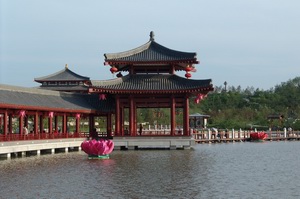 |
| Near
the Big Wild Goose Pagoda , Tang Paradise is
located in the Qujiang Resort, southeast of
the Xian City, Shaanxi Province. It is a newly
opened tourist attraction in April, 2005. Tang
Paradise covers a total area of 1000 mu (about
165 acres) and of which 300 mu (about 49 acres)
is water. This tourist attraction not only claims
to be the biggest cultural theme park in the
northwest region of China but also the first
royal-garden-like park to give a full display
of the Tang Dynasty's (618-907) culture.Altogether,
twelve scenic regions are distributed throughout
Tang Paradise to provide visitors with the enjoyment
of twelve cultural themes and a perfect exhibition
of the grandness, prosperity and brilliance
of the culture of the Tang Dynasty.
What
makes Tang Paradise incredible is that it is
no longer the garden mode of only water and
mountains in the Chinese traditional sense.
The outstanding designers of the magnificent
Tang Paradise have integrated almost everything
representative of the Tang Dynasty, such as
the poetry, the songs and dance, the marketplaces,
the food, the women's lifestyles, and science
into every site using cultural themes, thus
endowing every place with its own story and
its own place in the tapestry of Tang Dynasty
culture. |
Dining of Xi'an
|
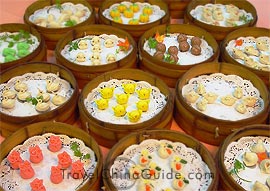 |
| Xian
is legendary as "the capital of table delicacies."
The ancient city is famous for the delicious
Shaanxi snack, the delicate Guangdong cuisine,
various kinds of fashionable foreign delicacies,
and the popular Sichuan cuisine, such as hot
pot.
Local
Food
Visitors to Xian must do two things: one is
to see the clay figures of terra cotta warriors
and horses. The other is to taste Yang
Rou Pao Mo (a soup dish that involves breaking
wheat flour flat bread into a bowl and adding
a delicious mutton stock). Before dinner, you
will be served one or two pieces of wheat flour
flat bread which you into tiny chunks, the smaller
the better. The waiter or the waitress will
then hand your bowl to the cook who mixes the
bread and mutton soup with an appropriate relish.
When the steaming hot meal is brought in, the
waiter will also offer you sweet crisp pickled
garlic, coriander, and hot pepper sauce. The
most famous, the Tong Sheng Xiang (Prosperity
and Fortune) Beef and Lamb Paomo Restaurant
done in Tang Dynasty style, is a time-honored
establishment in the Xian Bell and Drum Tower
Square.
Next
to Tong Sheng Xiang is a great restaurant, De
Fa Chang Dumpling Restaurant, with its own version
of the Dumpling
Banquet. Ingredients for the dumpling fillings
include various meats, vegetables, and seasonings.
Cooking methods include steaming, boiling, pan-frying,
deep frying, and roasting. Many flavors, including
salty, sweet, hot, and sour are offered. Other
house specialties include Peking dumplings,
steamed sweet bean paste buns, steamed shrimp
paste buns, and various uniquely spiced dishes.
While guests sample various delicacies, traditionally
waiters will explain the cuisine culture of
each dumpling.
One
of Xian's most famous specialties is the Guan
Tang Baozi (steamed buns served with sauces
inside) served at Jia Brothers' Restaurant in
Muslim Snack Street. You'll know you're there
when you see the monstrous blue arch over the
entrance and a wall festooned with photographs
of Xian notables -- TV hosts, writers, and musicians.
The specialty dish is Guan Tang Bao Zi, with
a choice of beef, lamb or "three flavors"
-- lamb, mushroom, and prawns. The buns have
piping-hot soup inside, so caution is advised.
This dish is best washed down with Ba Bao Xi
Fan, a bowl of sweet rice porridge filled with
peanuts, sultanas, hawthorn, and medlar berries.
Fanji
is the famous vendor of Shaanxi's most widely
consumed snack, Rou Jia Mo, finely chopped pork
stuffed in toasted wheat flour flat bread. A
piece of good-quality (youzhi) bread and a bowl
of mung bean flour soup will cost you no more
than RMB10. The state-run atmosphere is quaint
and friendly, and the numerous awards that decorate
the walls are well deserved. The restaurant
is in a lane opposite the Drum Tower, south
of West Main Street.
A
fascinating lure for food buffs is Local Snacks
Street (Hui Min Jie) near Drum Tower in Muslim
Square. On the two sides of the 500-meter street,
there are many restaurants of different cuisines
along with unique snack shops. While enjoying
true Muslim cuisine, tourists can learn customs
of the Hui people.
Besides
guan tang baozi in Jia Brothers' Restaurant,
there is barbeque in the Pingwa Kaorou Shop,
sour cabbage and beef fried rice in Honghong
Suancai Chaomi Restraunt, and beef noodles in
Yifenli Restaurant. Other offerings, including
fried persimmon cake (shi zi bing), fried dumpling
(guo tie), stir-fried bean jelly (chao liang
fen), chopped mutton fried in a wok with fine-ground
wheat (fen zheng rou), and beef and vegetable
pie (xian bing) are available on both sides
of the street.
If
you would like to taste all the local food at
one time in a budget meal, Xian Restaurant (Xian
Fan Zhuang) offers more than 100 varieties in
its first-floor self-service restaurant. It
charges only RMB18 per person, and is very popular
with visitors.
As
the center of northwest China, Xian provides
a wide range of table delicacies in addition
to local and traditional cuisine.
Please
visit ChinaTravelGide
to get more information about XI'AN. |
About
Xidian University
|
|
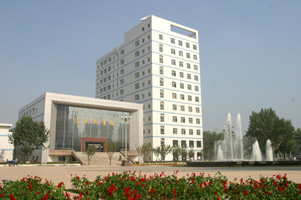 |
Xidian
University is among an elite class of institutes
for higher education selected nationally as
part of China's State educational development
project labeled "211". Xidian is a
key national university dedicated primarily
to electronic technology and information which
is integrated with a wide range of academic
subjects including engineering, physical science,
social science, foreign languages and business
management. In many years since Xidian University
was founded, it has grown rapidly in both size
and prestige. Now it has become a base of education
and high-tech research in the field of electronic
information.
Xidian
University is organized into more than 10 schools,
including Telecommunications, Electronic Engineering,
Computing, Technical Physics, Mechno-Electronic,
Management, Science, and Humanities. Xidian
has established a College for Continuing Education
and a Graduate School for postgraduate studies.
It offers over 30 specialties for undergraduates
and postgraduates.
|
|
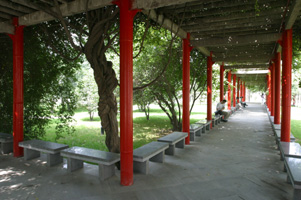 |
Xidian
University is home to 30,000 students, with
over 9000 postgraduates and over 20,000 undergraduates.
The faculty of Xidian University, numbering
over 3000, constitutes 1900 academic and technical
staff. A team of one academician of the China
Academy of Sciences, 100 Ph.D. advisors and
over 600 senior degree staff make up the professional
staff. Young and middle age holders of doctoral
and master's degrees compose 50% of the faculty.
Xidian
University has been accredited to grant doctoral
degrees for more 10 doctoral programs, grant
master's degrees for more than 30 master's programs,
and establish national level interdisciplinary
education for electric and electronic engineering.
Xidian has the approval to examine and designate
professors and advisors to doctoral students.
Xidian
University has a commitment to excellence in
both teaching and research as is demonstrated
by the number and variety of its study facilities.
They include: three national key laboratories
and over 30 research institutes and research
centers. The facilities of 75 research laboratories,
a multimedia video-audio center, training workshops
and 4 experimental centers are essential for
teaching. About 80% of teaching faculty hold
positions in the research activities. Xidian's
library has an inventory of over one million
books. The computer communications network of
the University provides access to national and
international universities.
|
Xidian University has been actively involved
with international academic exchanges and other
cooperative efforts. It has established cooperative
relations with prestigious colleges and universities
in over 20 countries, including the United States,
Japan, Great Britain, France, Germany, Australia,
and Russia. Currently, Xidian is involved with
joint research programs, cooperative training
of graduates, along with other academic and
scholarly exchanges. Some renowned foreign scholars
and experts have been invited to take positions
as honorable and visiting professors. Xidian
welcomes international applications and enrolls
over 50 overseas students every year.
|
|
|
The spirit of Xidian University is unity, diligence,
pragmatism, and creativity. The future goal
of Xidian University is to build Xidian University
into a first rate national university with its
academic status recognized internationally by
featuring electronics and information. At the
same time, Xidian will be combining, coordinating,
and developing engineering and physics as part
of the enhancement project "211" within
the next 10 years. |
|
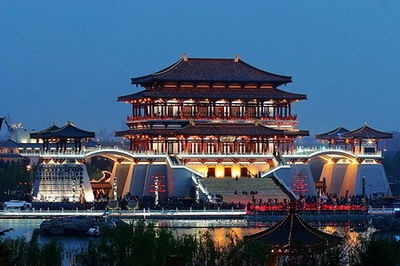
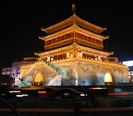
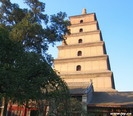
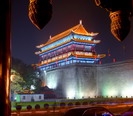
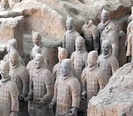

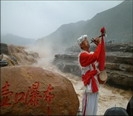
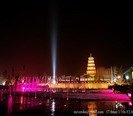
|

